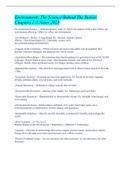Environment: The Science Behind The Stories Chapters 1-5 Notes 2023
Environmental Science - -Multidisciplinary study of 1)How the natural world works 2)How our environment affects us 3)How we affect our environment.
-Environment - -Biotic - Living things (Ex. Humans, animals, plants)
Abiotic - Non-living things (Ex. Continents, oceans, soil)
Social Relationships & Institutions
-Tragedy of the Commons - -When resources are open to the public and unregulated, they become overused, damaged, and depleted (Ex. Air & ocean).
-Agricultural Revolution - -The transition from hunter-gatherer to agricultural way of life 10,000 years ago. People began to grow crops, raise domestic animals, and settle down (Farms & villages). Result: Meet nutritional needs, live longer, produce more children.
-Industrial Revolution - -The shift from rural/agricultural life to urban (cities) society in the mid-
1700s.
-Ecosystem Services - -Essential services that support life. Ex. Purify air & water, regulate climate, pollinate plants, recycle waste, and cycle nutrients.
-Natural Resources - -Substances, energy sources, that we need.
-Nonrenewable Resources - -Runout, finite supply. Ex. Natural gas and fossil fuels.
-Renewable Resources - -Replenishable in short periods of time. Ex. Sunlight, wind energy, and wave energy.
-Environmental Issues - -Deforestation, pollution (Air, water, land, light, noise, etc.), overconsumption, overpopulation, climate change, and ignorance.
-Sustainable Solutions - -Must be socially desirable, economically feasible, and ecologically viable.
-IPAT Equation - -I = P x A x T
Human Impact on the Environment = Population x Affluence x Technology
-Systems - -Network of relationships that receive inputs, process inputs, and produce outputs. Energy flows through ecosystems and nutrients cycle within a system.
-Positive Feedback Loops - -As one increases, the other increases. As one decreases, the other decreases. -Negative Feedback Loops - -As one increases, the other decreases. As one decreases, the other increases.
-The 4 Natural Systems - -Lithosphere (Rock, sediment), atmosphere (Air), hydrosphere (All water), and biosphere (All living things).
-Eutrophication - -The process of 1)Nutrient enrichment (Nitrogen and phosphorus input, boost growth of phytoplankton). 2)Increased production of organic matter (Phytoplankton die and decomposed by bacteria). 3)Ecosystem degradation (Layers of fresh and salt water create oxygen
depletion/hypoxia, and drive away marine life.
-Water Cycle - -Humans have been extracting more groundwater and surface water over the years. By taking this water, natural amounts decrease, and certain areas (Particularly the Southwest U.S.) become drier.
-Carbon Cycle - -Humans extract fossil fuels from underground, and as we used them, carbon is put back into the atmosphere through fossil fuel emissions/combustion. There is also a reduced uptake of carbon by plants due to this, leading to deforestation.
-Phosphorus Cycle - -Humans use phosphorus for fertilizers and detergent. When humans mine phosphorus out of rocks, erosion occurs and more dust is created. This runs off into rivers and creates pollution.
-Nitrogen Cycle - -Humans use nitrogen as fertilizer due to its high amount of protein. Nitrogen often gets into groundwater and soil creating water pollution. By burning fossil fuels, carbon and
nitrogen are added into the atmosphere, which can pollute rivers through rainfall.
-Evolution - -Genetic change in a population of organisms across generations.
-Natural Selection - -Process in which traits that provide an advantage in survival/reproduction are passed on to future generations.
-Mutations - -Accidental changes in DNA.
-Misconceptions About Evolution - -Evolution doesn't always favor complexity, size, etc. It can sometimes favor simplicity depending on the setting. Different traits exist in different settings.
-Habitat - -An environment where an organism lives.
-Adaptation - -A trait that promotes success in a given habitat.
-Niche - -An organism's functional role (Ex. Feeding, interactions).
-Specialists - -Specific requirements, narrow breadth.
-Generalists - -Broader niches.




